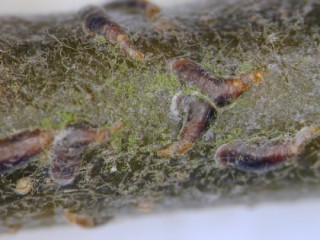
Mussel scale has one generation per year. Eggs are laid in the autumn and are deposited by the female under the scale shell before she dies.
- Eggs hatch in late May or early June and the first stage nymphs, known as crawlers, disperse over the tree during a period of approximately 4-6 weeks, though small numbers continue to emerge for several more weeks.
- The timing of migration varies between years depending on spring temperatures.
- When they have found a suitable feeding site, they settle mainly on the bark but also on fruitlets where they remain for the rest of their life.
- Each then moults to a second instar and then a third instar nymph, both stages being sedentary remaining in the same place and protected by the mussel-shaped scale formed from wax and the cast nymphal skin.
- In late August and September, each female deposits up to 80 eggs beneath the scale, then dies.
- The scale remains attached to the bark and protects the eggs through the winter.
- Although males appear in some races of mussel scale, only females occur on fruit crops and reproduction is entirely parthenogenetic.
